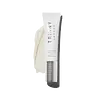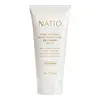What's inside
What's inside
 Key Ingredients
Key Ingredients

 Benefits
Benefits

 Concerns
Concerns

 Ingredients Side-by-side
Ingredients Side-by-side

Water
Skin ConditioningEthylhexyl Methoxycinnamate
UV AbsorberBenzophenone-3
UV AbsorberEthylhexyl Salicylate
UV AbsorberOctocrylene
UV AbsorberBis-Ethylhexyloxyphenol Methoxyphenyl Triazine
Skin ConditioningGlycerin
HumectantC12-15 Alkyl Benzoate
AntimicrobialCetyl Alcohol
EmollientDimethicone
EmollientMagnesium Aluminum Silicate
AbsorbentPhenoxyethanol
PreservativeBenzyl Alcohol
PerfumingBoron Nitride
AbsorbentEthylhexylglycerin
Skin ConditioningAcrylates/Ammonium Methacrylate Copolymer
Xanthan Gum
EmulsifyingSodium Lauryl Glucose Carboxylate
CleansingCetearyl Isononanoate
EmollientTriethyl Citrate
MaskingTocopheryl Acetate
AntioxidantParfum
MaskingLauryl Glucoside
CleansingCeteareth-20
CleansingCetearyl Alcohol
EmollientGlyceryl Stearate
EmollientBHT
AntioxidantDisodium EDTA
Caprylic/Capric Triglyceride
MaskingDehydroacetic Acid
PreservativeCitric Acid
BufferingHydrolyzed Eruca Sativa Leaf
AntioxidantGalactoarabinan
Ceteareth-12
EmulsifyingCetyl Palmitate
EmollientSodium Hyaluronate
HumectantArginine PCA
HumectantHoya Lacunosa Flower Extract
Skin ConditioningSodium Benzoate
MaskingPotassium Sorbate
PreservativePhaeodactylum Tricornutum Extract
HumectantCI 77891
Cosmetic ColorantCI 77491
Cosmetic ColorantCI 77492
Cosmetic ColorantCI 77499
Cosmetic ColorantWater, Ethylhexyl Methoxycinnamate, Benzophenone-3, Ethylhexyl Salicylate, Octocrylene, Bis-Ethylhexyloxyphenol Methoxyphenyl Triazine, Glycerin, C12-15 Alkyl Benzoate, Cetyl Alcohol, Dimethicone, Magnesium Aluminum Silicate, Phenoxyethanol, Benzyl Alcohol, Boron Nitride, Ethylhexylglycerin, Acrylates/Ammonium Methacrylate Copolymer, Xanthan Gum, Sodium Lauryl Glucose Carboxylate, Cetearyl Isononanoate, Triethyl Citrate, Tocopheryl Acetate, Parfum, Lauryl Glucoside, Ceteareth-20, Cetearyl Alcohol, Glyceryl Stearate, BHT, Disodium EDTA, Caprylic/Capric Triglyceride, Dehydroacetic Acid, Citric Acid, Hydrolyzed Eruca Sativa Leaf, Galactoarabinan, Ceteareth-12, Cetyl Palmitate, Sodium Hyaluronate, Arginine PCA, Hoya Lacunosa Flower Extract, Sodium Benzoate, Potassium Sorbate, Phaeodactylum Tricornutum Extract, CI 77891, CI 77491, CI 77492, CI 77499
Water
Skin ConditioningPropylene Glycol
HumectantCaprylic/Capric Triglyceride
MaskingEthylhexyl Methoxycinnamate
UV AbsorberGlyceryl Stearate
EmollientStearic Acid
CleansingGlycerin
HumectantMethylpropanediol
SolventTriethanolamine
BufferingMagnesium Aluminum Silicate
AbsorbentPhenoxyethanol
PreservativeAlumina
AbrasiveDimethicone
EmollientLecithin
EmollientCaprylyl Glycol
EmollientCellulose Gum
Emulsion StabilisingPolysorbate 20
EmulsifyingPropylene Glycol Stearate
Skin ConditioningTocopheryl Acetate
AntioxidantSimmondsia Chinensis Seed Oil
EmollientButyrospermum Parkii Butter Extract
Skin ConditioningSorbitan Laurate
EmulsifyingPhenylpropanol
MaskingCitrus Aurantium Dulcis Peel Oil
MaskingCananga Odorata Leaf Oil
MaskingLavandula Angustifolia Oil
MaskingStyrax Benzoin Gum
MaskingCamellia Sinensis Leaf Extract
AntimicrobialPropylene Glycol Laurate
Skin ConditioningAlcohol
AntimicrobialChamomilla Recutita Extract
Skin ConditioningPotassium Sorbate
PreservativeXanthan Gum
EmulsifyingCitric Acid
BufferingTitanium Dioxide
Cosmetic ColorantCI 77891
Cosmetic ColorantMica
Cosmetic ColorantCI 77491
Cosmetic ColorantCI 77492
Cosmetic ColorantCI 77499
Cosmetic ColorantWater, Propylene Glycol, Caprylic/Capric Triglyceride, Ethylhexyl Methoxycinnamate, Glyceryl Stearate, Stearic Acid, Glycerin, Methylpropanediol, Triethanolamine, Magnesium Aluminum Silicate, Phenoxyethanol, Alumina, Dimethicone, Lecithin, Caprylyl Glycol, Cellulose Gum, Polysorbate 20, Propylene Glycol Stearate, Tocopheryl Acetate, Simmondsia Chinensis Seed Oil, Butyrospermum Parkii Butter Extract, Sorbitan Laurate, Phenylpropanol, Citrus Aurantium Dulcis Peel Oil, Cananga Odorata Leaf Oil, Lavandula Angustifolia Oil, Styrax Benzoin Gum, Camellia Sinensis Leaf Extract, Propylene Glycol Laurate, Alcohol, Chamomilla Recutita Extract, Potassium Sorbate, Xanthan Gum, Citric Acid, Titanium Dioxide, CI 77891, Mica, CI 77491, CI 77492, CI 77499
Ingredients Explained
These ingredients are found in both products.
Ingredients higher up in an ingredient list are typically present in a larger amount.
This ingredient is an emollient, solvent, and texture enhancer. It is considered a skin-softener by helping the skin prevent moisture loss.
It helps thicken a product's formula and makes it easier to spread by dissolving clumping compounds.
Caprylic Triglyceride is made by combining glycerin with coconut oil, forming a clear liquid.
While there is an assumption Caprylic Triglyceride can clog pores due to it being derived from coconut oil, there is no research supporting this.
Learn more about Caprylic/Capric TriglycerideCi 77491 is also hydrated iron III oxide. It's sole purpose is to give a red/pink hue to products.
Iron III oxides are classified as inorganic chemicals for coloring.
Synthetically created Ci 77491 is considered safer than those naturally found. This is because the synthetically created version may contain less impurities. Iron oxides are generally non-toxic and non-allergenic.
Learn more about CI 77491Ci 77492 is also hydrated iron III oxide. It's sole purpose is to give a yellow hue to products.
Iron III oxides are classified as inorganic chemicals for coloring.
Synthetically created Ci 77492 is considered safer than those naturally found. This is because the synthetically created version may contain less impurities. Iron oxides are generally non-toxic and non-allergenic.
Learn more about CI 77492Ci 77499 is also hydrated iron III oxide. It is created from mixing red and black iron oxides. This helps give shades of darkness to a product.
Iron III oxides are classified as inorganic chemicals for coloring.
Ci 77891 is a white pigment from Titanium dioxide. It is naturally found in minerals such as rutile and ilmenite.
It's main function is to add a white color to cosmetics. It can also be mixed with other colors to create different shades.
Ci 77891 is commonly found in sunscreens due to its ability to block UV rays.
Learn more about CI 77891Citric Acid is an alpha hydroxy acid (AHA) naturally found in citrus fruits like oranges, lemons, and limes.
Like other AHAs, citric acid can exfoliate skin by breaking down the bonds that hold dead skin cells together. This helps reveal smoother and brighter skin underneath.
However, this exfoliating effect only happens at high concentrations (20%) which can be hard to find in cosmetic products.
Due to this, citric acid is usually included in small amounts as a pH adjuster. This helps keep products slightly more acidic and compatible with skin's natural pH.
In skincare formulas, citric acid can:
While it can provide some skin benefits, research shows lactic acid and glycolic acid are generally more effective and less irritating exfoliants.
Most citric acid used in skincare today is made by fermenting sugars (usually from molasses). This synthetic version is identical to the natural citrus form but easier to stabilize and use in formulations.
Read more about some other popular AHA's here:
Learn more about Citric AcidDimethicone is a type of synthetic silicone created from natural materials such as quartz.
What it does:
Dimethicone comes in different viscosities:
Depending on the viscosity, dimethicone has different properties.
Ingredients lists don't always show which type is used, so we recommend reaching out to the brand if you have questions about the viscosity.
This ingredient is unlikely to cause irritation because it does not get absorbed into skin. However, people with silicone allergies should be careful about using this ingredient.
Note: Dimethicone may contribute to pilling. This is because it is not oil or water soluble, so pilling may occur when layered with products. When mixed with heavy oils in a formula, the outcome is also quite greasy.
Learn more about DimethiconeEthylhexyl Methoxycinnamate is an organic compound that provides UVB protection. It often goes by the more common name of octinoxate. It is created from methoxycinnamic acid and 2-ethylhexanol.
Ethylhexyl Methoxycinnamate absorbs UVB rays with wavelengths between 280-320 nm. UV absorbers protect your skin by using chemical reactions to convert UV rays into heat and energy.
UVB (290-320 nm) rays emit more energy than UVA rays. They are capable of damaging DNA, causing sunburns and are thought to be linked to skin cancer.
The state of Hawaii has banned sunscreens containing octinoxate due to its potential impact on coral reefs. More research is needed to bridge gaps in this research. The European Union allows higher levels of octinoxate in sunscreens than the US and Australia.
Ethylhexyl Methoxycinnamate is oil soluble. It is not stable and may lose efficacy when exposed to sunlight.
Learn more about Ethylhexyl MethoxycinnamateGlycerin is already naturally found in your skin. It helps moisturize and protect your skin.
A study from 2016 found glycerin to be more effective as a humectant than AHAs and hyaluronic acid.
As a humectant, it helps the skin stay hydrated by pulling moisture to your skin. The low molecular weight of glycerin allows it to pull moisture into the deeper layers of your skin.
Hydrated skin improves your skin barrier; Your skin barrier helps protect against irritants and bacteria.
Glycerin has also been found to have antimicrobial and antiviral properties. Due to these properties, glycerin is often used in wound and burn treatments.
In cosmetics, glycerin is usually derived from plants such as soybean or palm. However, it can also be sourced from animals, such as tallow or animal fat.
This ingredient is organic, colorless, odorless, and non-toxic.
Glycerin is the name for this ingredient in American English. British English uses Glycerol/Glycerine.
Learn more about GlycerinGlyceryl Stearate is a mix of glycerin and stearic acid.
It is used to stabilize the mixing of water and oil ingredients. By preventing these ingredients from separating, it can help elongate shelf life. It can also help thicken the product's texture.
As an emollient, it helps soften skin and supports barrier-replenishing ingredients.
In cosmetics, Glyceryl Stearate is often made from vegetable oils or synthetically produced.
This ingredient may not be fungal-acne safe
Fun fact: The human body also creates Glyceryl Stearate naturally.
Learn more about Glyceryl StearateMagnesium Aluminum Silicate is a type of silica. It comes from naturally occuring minerals such as silicate ores and clay.
Magnesium aluminum silicate is used for enhancing texture and as an absorbent. Due to its large molecular size, it is unable to be absorbed into the skin.
Like other types of silica, this ingredient can be used to thicken a product. As an absorbent, it may be used to absorb extra water or help prevent clumping.
Although “aluminum” in an ingredient name can raise red flags for some consumers, the form and usage context matter significantly. For typical topical applications, there is no substantial evidence of health risks - such as cancer, neurotoxicity, or systemic “aluminum overload.”
Learn more about Magnesium Aluminum SilicatePhenoxyethanol is a preservative that has germicide, antimicrobial, and aromatic properties. Studies show that phenoxyethanol can prevent microbial growth. By itself, it has a scent that is similar to that of a rose.
It's often used in formulations along with Caprylyl Glycol to preserve the shelf life of products.
Potassium Sorbate is a preservative used to prevent yeast and mold in products. It is commonly found in both cosmetic and food products.
This ingredient comes from potassium salt derived from sorbic acid. Sorbic acid is a natural antibiotic and effective against fungus.
Both potassium sorbate and sorbic acid can be found in baked goods, cheeses, dried meats, dried fruit, ice cream, pickles, wine, yogurt, and more.
You'll often find this ingredient used with other preservatives.
Learn more about Potassium SorbateTocopheryl Acetate is AKA Vitamin E. It is an antioxidant and protects your skin from free radicals. Free radicals damage the skin by breaking down collagen.
One study found using Tocopheryl Acetate with Vitamin C decreased the number of sunburned cells.
Tocopheryl Acetate is commonly found in both skincare and dietary supplements.
Learn more about Tocopheryl AcetateWater. It's the most common cosmetic ingredient of all. You'll usually see it at the top of ingredient lists, meaning that it makes up the largest part of the product.
So why is it so popular? Water most often acts as a solvent - this means that it helps dissolve other ingredients into the formulation.
You'll also recognize water as that liquid we all need to stay alive. If you see this, drink a glass of water. Stay hydrated!
Learn more about WaterXanthan gum is used as a stabilizer and thickener within cosmetic products. It helps give products a sticky, thick feeling - preventing them from being too runny.
On the technical side of things, xanthan gum is a polysaccharide - a combination consisting of multiple sugar molecules bonded together.
Xanthan gum is a pretty common and great ingredient. It is a natural, non-toxic, non-irritating ingredient that is also commonly used in food products.
Learn more about Xanthan Gum